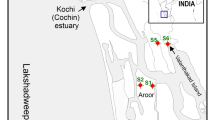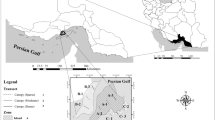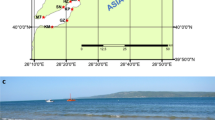Abstract
Macroinvertebrate community in the intertidal setup plays an important role in coastal ecosystem functions and biogeochemical cycle. However, different land use pattern may influence on their community structure, diversity, and composition in the coastal ecosystems. Using Van-Veen grab sampler, 60 sediment samples were seasonally collected from mangroves-dominated, aquaculture-dominated, and anthropogenically affected area in the lower intertidal zone of the Kohelia channel of Bangladesh, the Northern Bay of Bengal. We have tasted the variation in sediment properties across three land-use types in this intertidal habitat. To understand the patterns of benthic macroinvertebrate distribution, a neutral community model was applied. Our results showed that community composition and biodiversity of the benthic macroinvertebrate communities varied significantly between mangrove-dominated area with anthropogenically affected areas among the four seasons. The neutral community model revealed that community assembly of benthic macroinvertebrates in the lower intertidal habitats is structured by stochastic processes while sediment properties have significant influence on species distribution and interactions. Results suggested that land-use changes altered sediment properties and could change the diversity and distribution of the macroinvertebrate communities in the lower intertidal habitats.






Similar content being viewed by others
Data availability
Not applicable.
References
Abdullah Al M, Xu H, Akhtar A, Abu Hena MK, Islam MS, Alam MD, Alam MW, Uddin MM (2018) Seasonal shift in soft bottom-dwelling community structure in coastal waters of northern Bengal Bay, Bangladesh. Indian J Mar Sci 47(10):2021–2031
Abu Hena MK, Akhtar A, Khan MAA, Uddin SA, Rezowan M (2009) Community structure of macro benthos in an estuarine salt marsh habitat at Cox’s Bazar, Bangladesh. J Mar Sci 1:119–132
Anderson M, Gorley RN, Clarke KR, Warwick RM, Gorley RN (2008) PERMANOVA + for PRIMER user manual. Prim Ltd Regist 1(1):218
Anderson MJ, Walsh DCI (2013) PERMANOVA, ANOSIM, and the Mantel test in the face of heterogeneous dispersions: what null hypothesis are you testing? Ecol Monogr 83:557–574
APHA (American Public Health Association) (1989) Standard methods for the examination of water and wastewater. 17th, American Public Health Association, Washington DC, 164.
Bach L, Forbes VE, Dahllof I (2009) The amphipod Orchomenella pinguis– a potential bioindicator for contamination in the Arctic. Mar Pollut Bull 58(11):664–1670
Basset A, Sabetta L, Fonnesu A, Mouillot D, Chi TD, Viaroli P, Giordano G, Reizopoulou S, Abbiati M, Carrada GC (2006) Typology in Mediterranean transitional waters: new challenges and perspectives. Aquat Conserv Mar Freshwat Ecosyst 16:441–455
Bastian M, Heymann S, Jacomy M (2009) Gephi: an open-source software for exploring and manipulating networks. BT - International AAAI Conference on Weblogs and Social. Int AAAI Conf Weblogs Soc Media 361–362
Chainho P, Costa JL, Chaves ML, Lane MF, Dauer DM, Costa MJ (2006) Seasonal and spatial patterns of distribution of subtidal benthic invertebrate communities in the Mondego River, Portugal – a poikilohaline estuary. Hydrobiologia 555:59–74
Chave J (2004) Neutral theory and community ecology. Eco Lett 7(3):241–253
Clarke KR, Chapman MG, Somerfield PJ, Needham HR (2006) Dispersion-based weighting of species counts in assemblage analyses. Mar Ecol Prog Ser 320:11–27
Clarke KR, Gorley RN (2015) PRIMER 7: user manual/tutorial. PRIMER–E: Plymouth, United Kingdom.
Clarke KR, Green RH (1988) Statistical design and analysis for a ‘biological effects’ study. Mar Ecol Prog Ser 46:213–226
Cui C, Zhang Z, Er H (2021) Meiofaunal community spatial distribution and diversity as indicators of ecological quality in the Bohai Sea, China. J Ocean Univ China Oceanic and Coastal Sea Res 20(2):409–420
D’Alessandro M, Porporato EMD, Esposito V, Giacobbe S, Deidun A, Nasi F, Ferrante C, Auriemma R, Berto D, Renzi M, Scotti G, Consoli P, Negro PD, Andaloro F, Romeo T (2020) Common patterns of functional and biotic indices in response to multiple stressors in marine harbours ecosystems. Environ Pollut 259:113959. https://doi.org/10.1016/j.envpol.2020.113959
David RC, Kirsty JS (2006) The influence of dry–season conditions on the bottom dwelling fauna of an east Australian sub-tropical estuary. Hydrobiologia 560:345–361
de-la-Ossa-Carretero JA, Del-Pilar-Ruso Y, Giménez-Casalduero F, Sánchez-Lizaso JL, Dauvin JC (2012) Sensitivity of amphipods to sewage pollution. Estuar Coast Shelf Sci 96:129–138
Ellingsen KE (2002) Soft-sediment benthic biodiversity on the continental shelf in relation to environmental variability. Mar Ecol Prog Ser 232:15–27
Ellingsen KE, Gray JS (2002) Spatial patterns of benthic diversity: is there a latitudinal gradient along the Norwegian continental shelf? J Anim Ecol 71:373–389
Fargione J, Brown CS, Tilman D (2003) Community assembly and invasion: an experimental test of neutral versus niche processes. Proc Natl Acad Sci USA 100(15):8916–8920
Fauchald K (1977) The Polychaeta worms: definitions and keys to the orders, families, and genera. Natural History Museum of Los Angeles County, United Kingdom, Science Series 28:1–188
Fechner LC, Gourlay-Francé C, Tusseau-Vuillemin MH (2014) Linking community tolerance and structure with low metallic contamination: a field study on 13 biofilms sampled across the seine river basin. Water Res 51:152–162
Glasby CJ, Timm T, Muri AI, Gil J (2009) Catalogue of non–marine Polychaeta (Annelida) of the World. Zootaxa 2070:1–52
Hirst AJ (2004) Broad-scale environmental gradients among estuarine benthic macroinvertebratesl assemblages of south-eastern Australia: implications for monitoring estuaries. Mar Freshw Res 55:79–92
Hossain MS, Chowdhury SR, Chowdhury MAT (2007) Integration of remote rensing, GIS and participatory approach for coastal island resource use zoning in Bangladesh. Songklanakarin J Soc Sci Humanit 13(3):413–433
Josefson AB (2016) Species sorting of benthic invertebrates in a salinity gradient – importance of dispersal limitation. PLoS One 11(12):e0168908. https://doi.org/10.1371/journal.pone.0168908
Joydas TV, Krishnakumar PK, Qurban MA, Ali SM, Suwailem AA, Abdulkader KA (2011) Status of macro benthic community of Manifa-Tanajib Bay System of Saudi Arabia based on a once-off sampling event. Mar Pollut Bull 62:1249–1260
Kundu S, Mondal N, Lyla PS, Khan SA (2010) Biodiversity and seasonal variation of macrobenthic in faunal community in the inshore waters of Parangipettai Coast. Environ Monit Assess 163:67–79
Kuntke F, de Jonge N, Hesselsøe M, Lund Nielsen J (2020) Stream water quality assessment by metabarcoding of invertebrates. Ecol Ind 111:105982. https://doi.org/10.1016/j.ecolind.2019.105982
Lizarralde ZI, Pittaluga S (2010) Distribution and temporal variation of the benthic fauna in a tidal flat of the Rio Gallegos estuary, Patagonia, Argentina. Thalassas: an Int J Mar Sci 27(1):9–20
Marsden ID, Wong CHT, Muddafar NA (2000) Assessment on an Estuarine Amphipod (Paracorophium excavatum) as a bioindicator of contaminated sediment. Aust J Ecotoxicol 6:21–30
McArdle BH, Anderson MJ (2001) Fitting multivariate models to community data: a comment on distance-based redundancy analysis. Ecology 82:290–297
Montoya JM, Pimm SL, Solé RV (2006) Ecological networks and their fragility. Nature 442:259–264
Muir AI, Hossain MM (2014) The intertidal polychaete (Annelida) fauna of the Sitakunda coast (Chittagong, Bangladesh), with notes on the Capitellidae, Glyceridae, Lumbrineridae, Nephtyidae, Nereididae and Phyllodocidae of the “Northern Bay of Bengal Ecoregion.” Zookeys 23(419):1–27
Neckles HA, Dionne M (2000) Regional standards to identify and evaluate tidal wetland restoration in the Gulf of Maine. A GPAC Workshop, June 2-3, 1999. http://pubs.er.usgs.gov/publication/5200238
Nesemann H, Sharma G, Sinha RK (2003) Aquatic Annelida (Polychaeta, Oligochaeta, Hirudinea) of the Ganga River and adjacent water bodies in Patna (India: Bihar), with description of a new leech species (Family Salifidae). Annalen des Naturhistorischen Museums in Wien. Ser B Botanika Zool 105(B):139–187
Oksanen J, Blanchet FG, Friendly M, Kindt R, Legendre P, Minchin PR, O’Hara RB, Simpson GL, Solymos P, Stevens MHH, Szoecs E, Wagner H (2018) Community ecology package. R Package ‘vegan’ version 2.5–1
Oppong SK, Nsor CA, Buabeng GK (2021) Response of benthic invertebrate assemblages to seasonal and habitat condition in the Wewe River, Ashanti region (Ghana). Open Life Sci 16:336–353
Otani S, Kozuki Y, Yamanaka R, Sasaoka H, Ishiyama T, Okitsu Y, Sakai H, Fujiki Y (2010) The role of crabs (Macrophthalmus japonicus) burrows on organic carbon cycle in estuarine tidal flat, Japan. Estuar Coast Shelf Sci 86:434–440
Pavithran S, Ingole BS, Nanajkar M, Raghukumar C, Nath BN, Valsangkar AB (2009) Composition of macro benthos from the Central Indian Ocean Basin. J Earth Syst Sci 118(6):689–700
Pinder A (2010) Tools for identifying selected Australian aquatic oligochaetes (Clitellata: Annelida). Mus Vic Sci Rep 13:1–26
Platt HM, Lambshead PJD (1985) Neutral model analysis of patterns of marine benthic species diversity. Mar Ecol Prog Ser 24:75–81
Porst G, Brauns M, Irvine K, Solimini A, Sandin L, Pusch M, Miler O (2019) Effects of shoreline alteration and habitat heterogeneity on macroinvertebrate community composition across European lakes. Ecol Ind 98:285–296
Powell JR, Karunaratne S, Campbell CD, Yao HY, Robinson L, Singh BK (2015) Deterministic processes vary during community assembly for ecologically dissimilar taxa. Nat Commun 6:8444. https://doi.org/10.1038/ncomms9444
Pravinkumar M, Murugesan P, Prakash KR, Elumalai V, Viswanathan C, Raffi SM (2013) Benthic biodiversity in the Pichavaram mangroves, Southeast Coast of India. J Oceanogr Mar Sci 4(1):1–11
Ptatscheck C, Gansfort B, Majdi N, Traunspurger W (2020) The influence of environmental and spatial factors on benthic invertebrate metacommunities differing in size and dispersal mode. Aquat Ecol 54:447–461
Quiroz-Martinez B, Schmitt FG, Dauvin J-C, Dewarumez J-M, Foveau A, Garcia C (2011) Regional patterns of continental shelf polychaete diversity: examples for the North Sea, English Channel, Irish Sea and Outer Bristol Channel areas. Ital J Zool 78(S1):324–332
Samidurai K, Saravanakumar A, Kathiresan K (2012) Spatial and temporal distribution of macro benthos in different mangrove ecosystems of Tamil Nadu Coast, India. Environ Monit Assess 184:4079–4096
Sharma KK, Chowdhary S (2011) Macroinvertebrate assemblages as biological indicators of pollution in a Central Himalayan River, Tawi (J&K). Int J Biodivers Conserv 3(5):167–174
Silva RF, Filho JSR, Souza SR, Filho PWS (2011) Spatial and temporal changes in the structure of soft-bottom benthic communities in an Amazon estuary, Caete estuary, Para, Brazil. J Coastal Res 64:440–444
Sloan WT, Lunn M, Woodcock S, Head IM, Nee S, Curtis TP (2006) Quantifying the roles of immigration and chance in shaping prokaryote community structure. Environ Microbiol 8(4):732–740
Somerfield PJ, Gee JM, Warwick RM (1994) Soft sediment meiofaunal community structure in relation to a long-term heavy metal gradient in the Fal Estuary system. Mar Ecol Prog Ser 105:79–88
Stegen JC, Lin X, Fredrickson JK, Chen X, Kennedy DW, Murray CJ, Rockhold ML, Konopka A (2013) Quantifying community assembly processes and identifying features that impose them. ISME J 7:2069–2079
Tikhonov G, Abrego N, Dunson D, Ovaskainen O (2017) Using joint species distribution models for evaluating how species-to-species associations depend on the environmental context. Methods Ecol Evol 8:443–452
Verberk WCEP, van der Velde G, Esselink H (2010) Explaining abundance–occupancy relationships in specialists and generalists: a case study on aquatic macroinvertebrates in standing waters. J Anim Ecol 79:589–601
von der Ohe PC, Goedkoop W (2013) Distinguishing the effects of habitat degradation and pesticide stress on benthic invertebrates using stressor-specific metrics. Sci Total Environ 444:480–490
Wang X, Chen R, Berry A (2003) Sources and preservation of organic matter in Plum Island salt marsh sediments (MA, USA): long-chain n-alkanes and stable carbon isotope compositions. Estuar Coast Shelf Sci 58:917–928
WoRMS Editorial Board (2022) World Register of Marine Species. Available from https://www.marinespecies.org at VLIZ. Accessed 30 Apr 2022
Yang Y, Yi Y, Zhou Y, Wang X, Zhang S, Yang Z (2020) Spatio-temporal variations of benthic macroinvertebrates and the driving environmental variables in a shallow lake. Ecol Ind 110:105948. https://doi.org/10.1016/j.ecolind.2019.105948
Ysebaert T, Herman PMJ (2002) Spatial and temporal variation in benthic macro fauna and relationships with environmental variables in an estuarine, intertidal soft-sediment environment. Mar Ecol Prog Ser 244:105–124
Yu X, Yang J, Liu L, Tian Y (2015) Effects of Spartina alterniflora invasion on biogenic elements in a subtropical coastal mangrove wetland. Environ Sci Pollut Res 22:3107–3115
Zhou J, Wu Y, Kang Q, Zhang J (2007) Spatial variations of carbon, nitrogen, phosphorous and sulfur in the salt marsh sediments of the Yangtze Estuary in China. Estuar Coast Shelf Sci 71:47–59
Zhou JZ, Deng Y, Zhang P, Xue K, Liang YF, Van Nostrand JD, He ZL, Wu LY, Stahl DA, Hazen TC, Tiedje JM, Arkin AP (2014) Stochasticity, succession, and environmental perturbations in a fluidic ecosystem. Proc Natl Acad Sci USA 111:E836–E845
Acknowledgements
We thank Prof. Alexander I. Muir (The Natural History Museum, London SW7 5BD, UK) for providing the taxonomic list of Indian Ocean Basin benthic fauna for cross-checking the identified species. We also would like to thank to fisherman and local community who helped during sample collection and field preservation in such remote area especially, Mr. Abu Bakkar, Md. Shahdat Hossain, Md. Saiful Islam Sajjad and Md. Saybal. Especial thanks to David Marioni for English corrections and two anonymous reviewers for their constructive suggestions and valuable comments for improving the understanding and interpretation.
Funding
This work was financially supported by Bangladesh Nature Foundation (BNF, Cox’s Bazar) (1st author) and the University Grants Commission, Bangladesh (UGC) (2nd author).
Author information
Authors and Affiliations
Contributions
MAA and AA: conceived the idea, formal analysis, validation and wrote the first draft. MAA, AA, AHMK and HB: sample collection and processing. HB and AA: processed the sediment samples and measured the sediment parameters. MAA and AA: performed the microscopic observation. AHMK, SAU, MSI and MHA: critically review, validation and revised the manuscript. LM, MHI and MHA: research collaboration and manuscript revision. Finally, all authors approved the final version of the manuscript and agreed to submit.
Corresponding author
Ethics declarations
Ethics approval
Not applicable.
Consent to participate
Not applicable.
Consent for publication
Not applicable.
Conflict of interest
The authors declare no competing interests.
Additional information
Responsible Editor: V.V.S.S. Sarma
Publisher's note
Springer Nature remains neutral with regard to jurisdictional claims in published maps and institutional affiliations.
Aysha Akhtar and Hillol Barua are co-first author.
Rights and permissions
About this article
Cite this article
Abdullah Al, M., Akhtar, A., Barua, H. et al. Intertidal macroinvertebrate community structure in a subtropical channel is driven by sediment properties across different land-use types. Environ Sci Pollut Res 29, 66389–66404 (2022). https://doi.org/10.1007/s11356-022-20471-z
Received:
Accepted:
Published:
Issue Date:
DOI: https://doi.org/10.1007/s11356-022-20471-z




